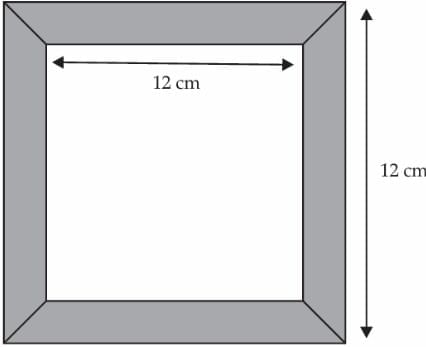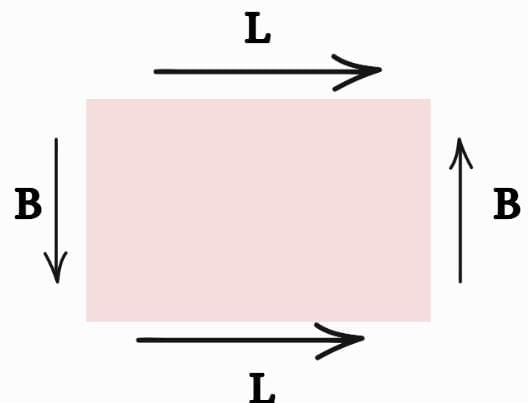Case Based Questions: Perimeter and Area | Mathematics for Class 6 PDF Download
Q1: Read the source and answer the question that follows
The figure below shows a square wooden frame enclosing a square picture.

Q1. What is the area (in cm2) of the frame?
(a) 81
(b) 144
(c) 181
(d) 225
Ans. Option (a) is correct.
Explanation: Area of frame
= area of outer square – area of inner square
= 152 – 122
= 225 – 144
= 81 cm2
Q2. What is the perimeter (in cm) of the picture?
(a) 12
(b) 48
(c) 60
(d) 144
Ans. Option (b) is correct.
Explanation: Perimeter of square = 4a = 4 × 12 = 48 cm
Q2: Read the source and answer the question that follows
Sohail and Tara are studying perimeter in their math class. Sohail asks Tara how to find the perimeter of a rectangle. Tara explains that the perimeter of a rectangle is calculated by adding the lengths of all four sides. In simpler terms, it’s like walking around the edge of a rectangle and measuring the total distance. For example, if the length of a rectangle is 10 meters and the width is 5 meters, the perimeter is 2 × (10 + 5) = 30 meters. Sohail is amazed at how easy it is to calculate the perimeter of basic shapes. Tara also mentions that the perimeter of a square is similar but simpler, as all four sides are equal. For example, a square with a side length of 6 cm would have a perimeter of 4 × 6 = 24 cm.
Q1. How do you calculate the perimeter of a rectangle?
(a) Length + Width
(b) 2 × (Length + Width)
(c) Length × Width
(d) 4 × Length
Ans: (b) 2 × (Length + Width)
Explanation: The perimeter of a rectangle is calculated by adding the lengths of all four sides, or by using the formula 2 × (Length + Width).
Q2. What is the perimeter of a square with a side length of 7 cm?
(a) 7 cm
(b) 14 cm
(c) 28 cm
(d) 21 cm
Ans: (c) 28 cm
Explanation: The perimeter of a square is 4 times the length of one side. So, 4 × 7 = 28 cm.
Q3. If a rectangular garden has a length of 12 meters and a width of 4 meters, what is its perimeter?
Ans: The perimeter is 2 × (12 + 4) = 32 meters.
Q3: Read the source and answer the question that follows
Sanjay and Meera were tasked with calculating the area of different shapes. Sanjay designed a rectangular path with a length of 50 meters and a width of 20 meters. Meera created a square path with each side measuring 25 meters. Sanjay calculated the perimeter of his rectangular path as 2 × (50 + 20) = 140 meters and the area as 50 × 20 = 1000 square meters. Meera calculated the perimeter of her square path as 4 × 25 = 100 meters and the area as 25 × 25 = 625 square meters. Sanjay was amazed to find that even though Meera's path had a smaller perimeter, it covered less area.
Q1. If a rectangle has a length of 15 meters and a width of 10 meters, what is its perimeter?
(a) 30 meters
(b) 50 meters
(c) 25 meters
(d) 40 meters
Ans: (b) 50 meters
Explanation: The perimeter of a rectangle is 2 × (Length + Width),
so 2 × (15 + 10) = 50 meters.
Q2. What is the area of a square with a side length of 6 meters?
(a) 12 m²
(b) 36 m²
(c) 24 m²
(d) 18 m²
Ans: (b) 36 m²
Explanation: The area of a square is side × side, so 6 meters × 6 meters = 36 square meters.
Q3. How would you calculate the total area if you want to plant flower beds of size 4 meters by 4 meters in a rectangular garden of size 12 meters by 8 meters?
Ans: The area of the garden is 12 meters × 8 meters = 96 m²
If each flower bed is 4 meters by 4 meters, the area of one flower bed is 4 × 4 = 16 m².
Depending on how many beds fit in the garden, you can calculate how much space is used.
|
48 videos|334 docs|23 tests
|
FAQs on Case Based Questions: Perimeter and Area - Mathematics for Class 6
| 1. What is the formula for calculating the perimeter of a rectangle? |  |
| 2. How do you find the area of a triangle? |  |
| 3. What is the difference between perimeter and area? |  |
| 4. How can I calculate the area of a rectangle? |  |
| 5. Can the perimeter of a shape be calculated if only the area is known? |  |
















